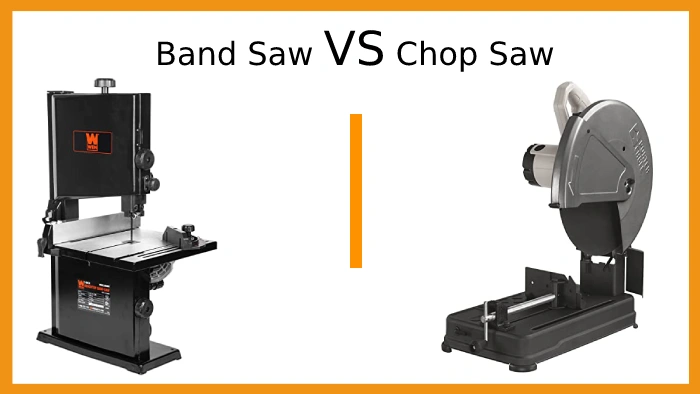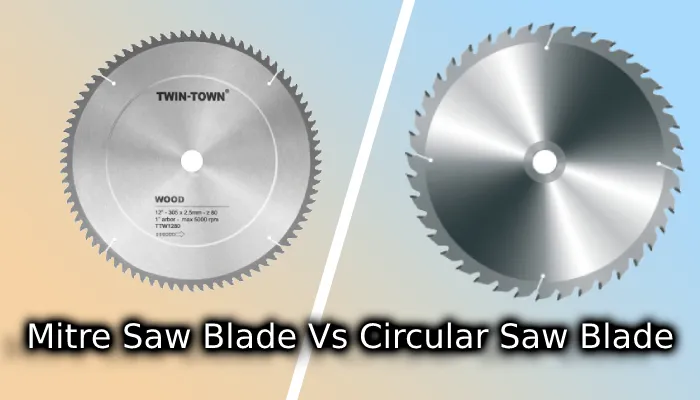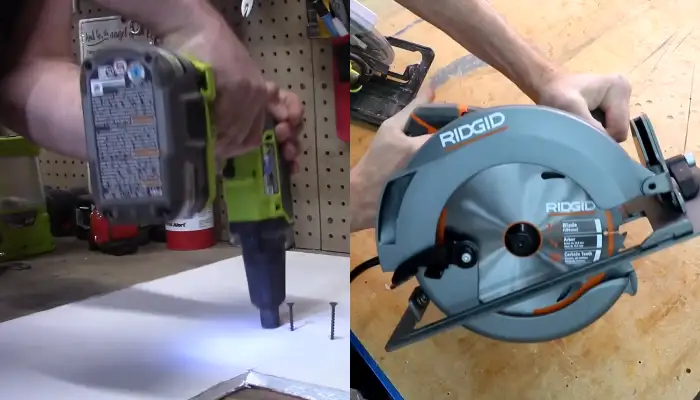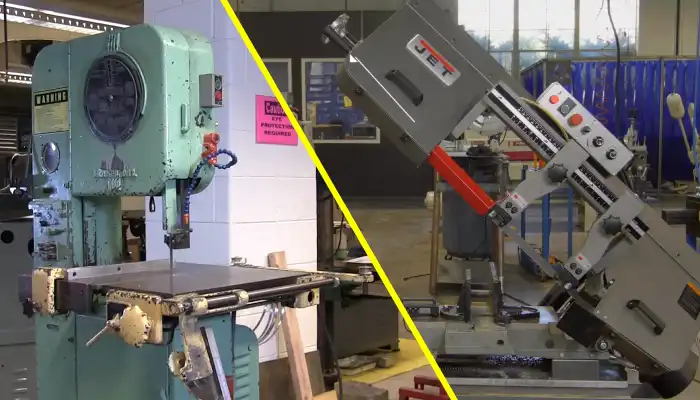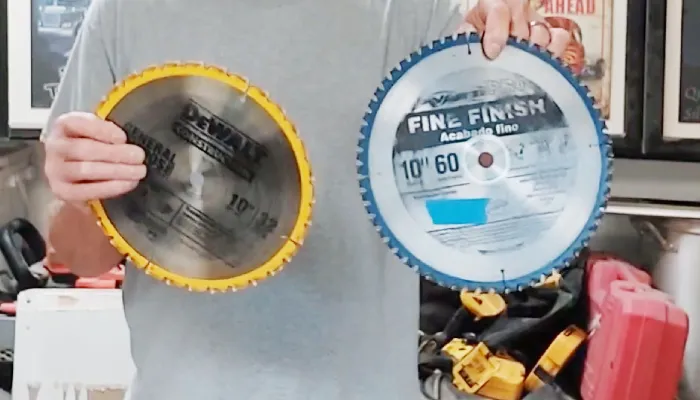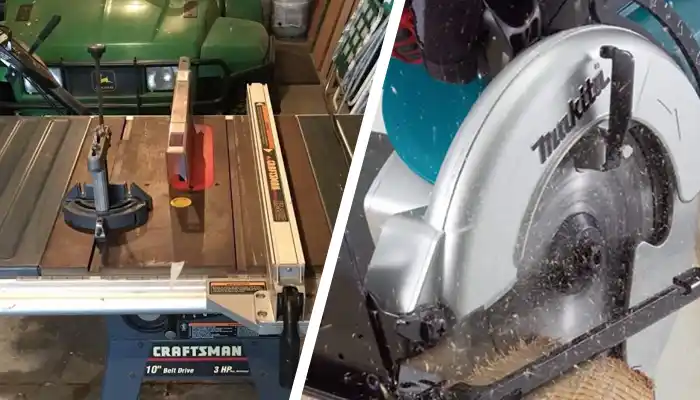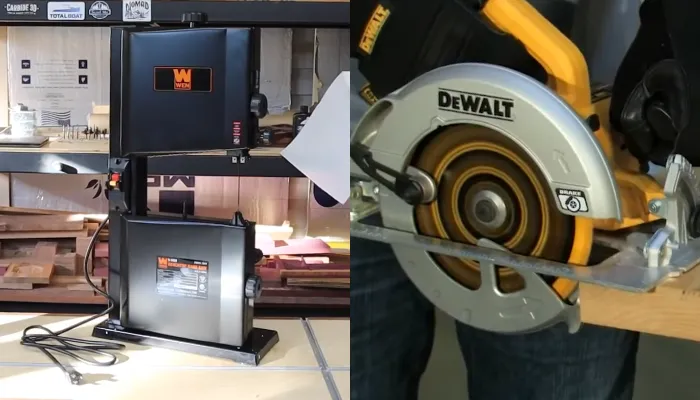Band Saw vs Chop Saw: 7 Key Differences
Band saws and chop saws are both powerful cutting tools that serve specific purposes in the woodworking and metalworking industries. Their unique cutting mechanisms, varying types, and applications make them versatile and efficient in their respective tasks.
Based on my research, I have identified some major differences between these two powerful cutting tools. The cutting mechanism is one of the most significant differences. A band saw operates on a continuous loop blade that moves between two wheels, while a chop saw utilizes a circular steel saw blade spinning at high speed.
I will discuss the differences between the band saw and chop saw to help you better understand which cutting tool best suits your needs.
- 3.5-amp motor for powerful cuts
- Two-speed operation (1520/2620 FPM)
- 72-inch blades, 1/8 to 1/2 inches
- 14-1/8 x 12-1/2 inch work table
- Includes work light and 2-year warranty
- 15 Amp High-Performance Motor
- Quick-Change Keyless Blade System
- Adjustable Quick-Fence for Precision
- Quick-Lock Vise for Fast Clamping
- Ergonomic D-Handle for Comfort
7 Major Differences Between Band Saw and Chop Saw
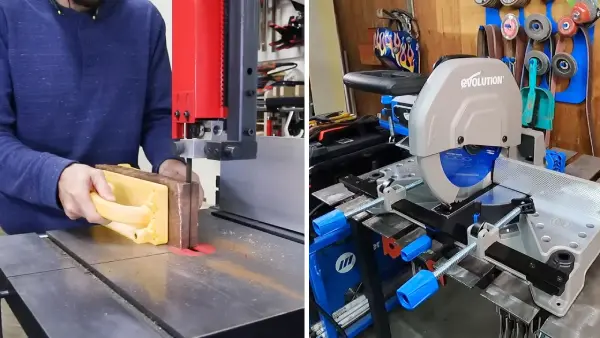
There are several major differences between a band saw and a chop saw that I found notable, each contributing to distinct functionalities and applications.
- Cutting mechanism
- Types and applications
- Speed and efficiency
- Power consumption
- Handling of large stock
- Noise level
- Ease of blade change
1. Cutting Mechanism
On the basis of my findings, the band saw operates using a continuous loop blade that moves between two wheels. This design allows for a versatile cutting motion, as the blade can move in any direction. Due to the downward motion of the blade, the band saw can make intricate and detailed cuts on a wide variety of materials.
On the other hand, the chop saw utilizes a circular steel saw blade that spins at high speed. This design excels in accurate crosscutting, making it ideal for straight cuts in wood. The chop saw’s spinning blade provides a fast and efficient cutting action but is less versatile than the band saw.
2. Types and Applications
Band saws come in various types, including horizontal, vertical, benchtop, floor standing, and portable/handheld models. Each type is designed to cater to specific purposes.
For instance, horizontal band saws are commonly used for metal cutting, while vertical band saws are ideal for woodworking tasks. Benchtop band saws are compact and suitable for small-scale projects, while floor-standing band saws are more robust and suitable for heavy-duty applications.
Meanwhile, chop saws also have varied types, such as standard, compound, dual-compound, and sliding-compound chop saws. These saws are primarily used for accurate crosscuts in woodworking projects, making them popular among carpenters and DIY enthusiasts.
3. Speed and Efficiency
The band saw generally operates slower than chop saws, but its cleaner and more accurate cuts make it suitable for tasks where precision is crucial. This makes them particularly suitable for tasks where precision is crucial, such as intricate woodworking or cutting curves in various materials.
Conversely, chop saws are known for their speed, making them highly efficient for quick and precise crosscuts. However, the trade-off for this speed may be a rougher edge that requires additional touch-ups.
4. Power Consumption
Band saws consume power based on the motor size and the type of work being performed. Smaller benchtop models may have lower power requirements, while larger industrial band saws may demand more electricity.
In contrast, chop saws typically consume less power than larger band saws. The straightforward cutting action of the circular blade contributes to energy-efficient operation. This makes chop saws suitable for tasks requiring less power and precision, such as cutting through metal pipes or wooden beams.
5. Handling of Large Stock
Due to its design and ability to make intricate cuts, the band saw is particularly well-suited for handling large stock. Its long, continuous blade runs on two wheels, allowing it to handle larger workpieces easily.
The blade’s continuous motion also enables the band saw to make precise cuts, making it ideal for tasks like resawing and processing sizable workpieces. Additionally, the band saw’s adjustable fence and table provide stability and support, ensuring accurate and controlled cuts on large stock.
On the other hand, while efficient for crosscutting smaller to medium-sized stock, the chop saw may not have the capacity to handle very large workpieces due to its design limitations. Therefore, the band saw is the superior choice if you frequently work with large stock.
6. Noise Level
I have observed notable differences in comparing the noise levels of a band saw and a chop saw. Band saws generally operate at a quieter noise level compared to chop saws. This is due to the design and mechanics of the band saw, which allows for smoother cutting and less vibration.
The noise reduction is particularly advantageous in environments where noise reduction is a consideration, such as workshops or residential areas.
Meanwhile, several woodworking enthusiasts have pointed out that chop saws tend to produce more noise, especially when cutting through tougher materials. The high-speed rotation of the circular blade contributes to the overall noise level.
7. Ease of Blade Change
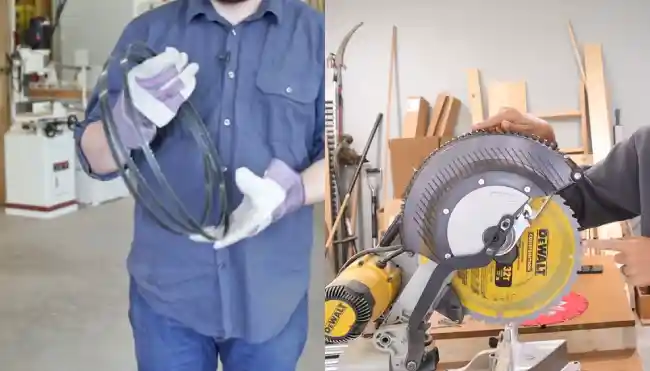
Changing the blade on a band saw is more involved than a chop saw, requiring adjustments and proper tensioning. With a band saw you’ll need to loosen the tension on the blade, remove the blade guards, and open the blade guide assembly to access the blade.
Once the old blade is removed, you’ll need to install the new one, ensuring it’s properly tensioned and aligned. This involves adjusting the tension knob or lever, aligning the blade with the guides, and reattaching the blade guards.
Conversely, changing the blade on a chop saw is often simpler. Many models come with quick-change systems, allowing you to remove and replace blades easily without any additional adjustments or tensioning. This can be a significant advantage when working on projects that require frequent blade changes for different cutting tasks.
Band Saw and Chop Saw Comparison Chart
| Aspects | Band Saw | Chop Saw |
| Cutting Mechanism | Operates with a continuous loop blade, ideal for versatile cuts. | Utilizes a spinning circular steel blade for accurate crosscuts. |
| Types and Applications | Various types for woodworking and metal cutting purposes. | Varied models for accurate crosscuts in woodworking. |
| Speed and Efficiency | Slower speed, offering cleaner and more accurate cuts. | Known for speed and efficiency, but may result in rougher edges. |
| Power Consumption | Power consumption varies based on the motor size and type. | Typically consumes less power, contributing to efficiency. |
| Handling of Large Stock | Well-suited for handling large stock and making intricate cuts. | Efficient for crosscutting smaller to medium-sized stock. |
| Noise Level | Operates at a generally quieter noise level. | Tends to produce more noise, especially with tougher materials. |
| Ease of Blade Change | Changing the blade can be more involved but offers flexibility. | Blade changes are often more straightforward, aiding versatility. |
What blade size is generally used for making curved cuts with a bandsaw?
When making curved cuts with a bandsaw, the ideal blade size is typically a narrow-width blade. A 1/8′ or 3/16′ blade with 10-14 teeth per inch is suitable for tight curves and delicate materials. This type of blade provides the necessary precision and control for intricate cuts.
In contrast, if you’re dealing with curves exceeding a 5/8′ radius or prioritizing cut quality over speed, a 1/4′ blade with 6 teeth per inch is a reliable choice. This blade size is available in standard or skip-tooth variants and offers a smooth finish.
For stellar curve performance, exploring 1/2′ blade options such as 3 TPI or 14 TPI is recommended. These blades provide the precision needed for projects like crafting a rocking chair, ensuring a high-quality result.
To further enhance the precision and control during curved cuts, it’s essential to minimize bandsaw drift. Ensuring proper blade tension, alignment and maintaining the bandsaw according to manufacturer recommendations significantly reduce drift, resulting in more accurate and controlled curved cuts.
Can I use a wood-cutting chop saw blade on metal?
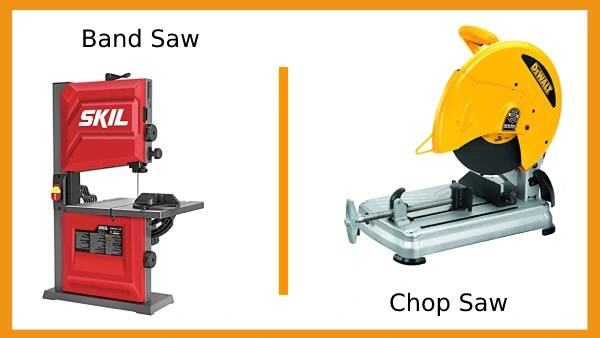
Using a wood-cutting chop saw blade on metal isn’t recommended due to its lack of durability and tooth geometry for harder metals. These blades are designed specifically for cutting wood and aren’t equipped to handle the challenges posed by cutting through metal.
The teeth on a wood-cutting blade are typically larger and have a different shape than blades designed for metal cutting. This difference in tooth geometry affects the blood’s ability to cut through metal effectively, reducing cutting performance and potentially causing blade fatigue and damage.
In addition, using a wood-cutting blade on metal can also lead to an increased risk of kickbacks and accidents. It’s advisable to use blades specifically designed for cutting metal to ensure optimal cutting results and maintain safety.
Regardless of whether you are cutting wood or metal, it is advisable to use a high-quality circular-shape blade designed for the specific material. This ensures the blade’s durability, efficiency, and overall safety during the cutting process. Choosing the right tool for the job is essential for achieving accurate cuts and preventing unnecessary wear and tear on the equipment.
Use Band Saw or Chop Saw Based on Your Specific Project Requirements
In terms of choosing between a band saw and a chop saw, it ultimately depends on the type of cuts you need to make. Analyze the differences that I have pointed out, including cutting mechanisms, types, and applications, speed, power consumption, handling large stock, noise level, and blade change ease.
If you prioritize versatility, intricate cuts, and handling large stock, a band saw might be your ideal choice. On the other hand, if speed and efficiency for precise crosscuts are your primary requirements, a chop saw could be more suitable.
Evaluate your specific needs to determine which woodworking tool aligns best with your projects.
- Powerful 2.8 Amp Induction Motor
- 2-Speed Drive System with Tool-Free Tensioning
- Quick and Accurate Blade Tension Setting
- Precision Ball Bearing and Lower Guides
- Rack and Pinion Table Adjustment
- Powerful 15 Amp Motor for Precision
- Tungsten Carbide-Tipped Blade for Clean Cuts
- Portable Design with Pressed Steel Base
- Miter Saw with 0-45° Angle Capability
- Blades for Versatile Material Cutting
Last update on 2025-07-09 / Affiliate links / Images from Amazon Product Advertising API

